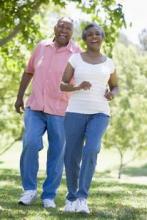Physical activity improves specific components of heart-rate variability in a dose-dependent manner among older adults, according to a report published May 6 in Circulation.
This suggests that "any physical activity is better than none, and more is [even] better" for men and women aged 65 and older, said Luisa Soares-Miranda, Ph.D., of the Research Centre in Physical Activity, Health, and Leisure, University of Porto (Portugal), and her associates (Circulation 2014 May 6 [doi:10.1161/CIRCULATIONAHA.113.005361]).
They analyzed data regarding 985 participants in the population-based Cardiovascular Health Study, in which older men and women (average age 71.5 years) residing in four U.S. communities at baseline during 1989-1990 were followed for 10 years for cardiovascular events.
For their study, Dr. Soares-Miranda and her colleagues reviewed 24-hour Holter monitor recordings obtained in a subset of those participants at enrollment and at 5-year follow-up. The individuals completed detailed questionnaires about the frequency and duration of their usual activities, including walking, gardening, swimming, aerobics, golfing, dancing, and riding an exercise cycle.
Activity level showed a linear association with higher 24-hour standard deviation of all normal-to-normal-intervals (SDNN), higher ultra-low-frequency power (ULF), and fewer episodes of erratic heart-rate variability on Holter monitoring, all of which reduce the risk of MI and heart failure.
"For example ... the higher values of SDNN that we observed in the highest versus lowest quartile of leisure-time activity would correspond to an approximately 11% lower risk of cardiac events," the investigators said.
In addition, people who increased their walking distance or pace during the first 5 years of follow-up showed significantly higher SDNN and ULF and significantly fewer episodes of heart-rate variability than did those who maintained or decreased their walking distance or pace, said Dr. Soares-Miranda, also of Harvard School of Public Health, Boston.
These findings suggest not only that regular physical activity in later life is beneficial but also that certain benefits may be lost when physical activity is reduced or stopped – "supporting the need to maintain modest physical activity throughout the aging process," they added.
This study was supported by the National Heart, Lung, and Blood Institute, the National Institute of Neurological Disorders and Stroke, the National Institute on Aging, and the Portuguese Foundation for Science and Technology. Dr. Soares-Miranda and her associates reported no financial conflicts of interest.

